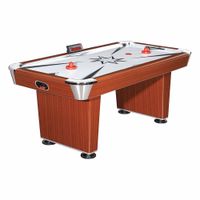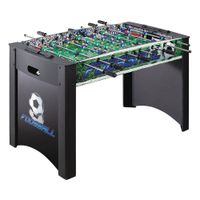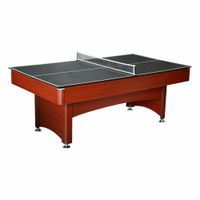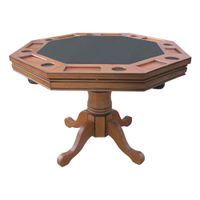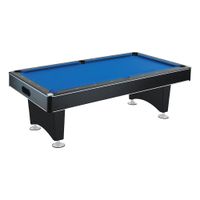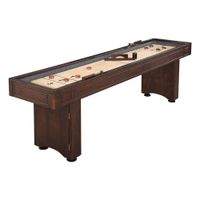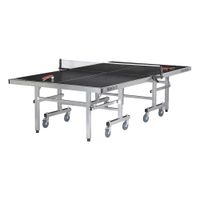Call +(254) 703 030 000 / 751 483 999 / 721 704 777
.....Read More
Frequently Asked Questions
What are the dimensions of a standard pool table?
A standard pool table, often used in professional tournaments, typically comes in two main sizes: 9-foot and 8-foot tables.
1. **9-Foot Table**:
- **Playing Surface Dimensions**: 100 inches by 50 inches (254 cm by 127 cm).
- **Overall Dimensions**: Approximately 112 inches by 62 inches (284 cm by 157 cm), accounting for the table's rails and outer structure.
- This size is commonly used in professional settings and is often referred to as a "tournament size" table.
2. **8-Foot Table**:
- **Playing Surface Dimensions**: 88 inches by 44 inches (224 cm by 112 cm).
- **Overall Dimensions**: Approximately 100 inches by 56 inches (254 cm by 142 cm).
- This size is popular for home use and is often considered a "recreational" or "home" size table.
Both sizes maintain a consistent ratio of length to width, which is 2:1. The height of a standard pool table from the floor to the top of the playing surface is typically between 29.25 inches and 31 inches (74.3 cm to 78.7 cm).
When setting up a pool table, it's important to consider the space required around the table for comfortable play. Ideally, there should be at least 5 feet (1.5 meters) of clearance on all sides to accommodate cue sticks and allow players to move freely.
How do you maintain a poker table?
To maintain a poker table, follow these steps:
1. **Regular Cleaning**: Use a soft brush or vacuum with a brush attachment to remove dust and debris from the felt surface. Avoid using harsh chemicals; instead, use a damp cloth with mild soap for spot cleaning.
2. **Protect the Felt**: Encourage players to avoid eating or drinking directly over the table. Use coasters and provide side tables for drinks. Consider using a table cover when the table is not in use to protect it from dust and spills.
3. **Inspect and Repair**: Regularly check for any tears or wear on the felt. Small tears can be repaired with fabric glue. For significant damage, consider replacing the felt.
4. **Leg and Frame Maintenance**: Tighten any loose screws or bolts on the table legs and frame. Ensure the table is stable and level to prevent wobbling during play.
5. **Chip and Card Care**: Clean poker chips with a damp cloth and mild soap. Ensure cards are not bent or damaged; replace them as needed to maintain a professional playing experience.
6. **Storage**: If the table is foldable, store it in a dry, cool place to prevent warping or damage. Use a protective cover to shield it from dust and moisture.
7. **Environmental Control**: Keep the room at a moderate temperature and humidity level to prevent the felt from stretching or shrinking.
8. **Professional Servicing**: Occasionally, have the table professionally serviced to ensure longevity and optimal playing conditions.
By following these steps, you can maintain your poker table in excellent condition, ensuring a great playing experience for years to come.
What games can be played on a multi-game table?
A multi-game table is a versatile piece of furniture designed to offer multiple gaming options in one unit. Common games that can be played on a multi-game table include:
1. **Billiards/Pool**: Many multi-game tables feature a pool table surface, complete with cues, balls, and pockets.
2. **Table Tennis**: A table tennis top can often be placed over the pool table, allowing for quick conversion.
3. **Air Hockey**: Some tables include an air hockey surface, complete with a blower motor for smooth puck movement.
4. **Foosball**: A foosball table setup is a popular inclusion, featuring rods with player figures for a soccer-like game.
5. **Shuffleboard**: Certain tables offer a shuffleboard surface, allowing players to slide pucks towards scoring zones.
6. **Chess/Checkers**: A board for chess or checkers is often included, sometimes as a reversible top.
7. **Backgammon**: Some tables provide a backgammon board, complete with dice and pieces.
8. **Poker/Card Games**: A felt-covered surface for poker or other card games is a common feature.
9. **Darts**: Some multi-game tables come with a dartboard attachment or a separate dartboard.
10. **Bowling**: Miniature bowling setups can be included, offering a scaled-down version of the game.
11. **Ping Pong**: Similar to table tennis, but sometimes with a smaller or differently designed surface.
12. **Dominoes**: A flat surface for dominoes is sometimes part of the package.
These tables are designed to maximize entertainment while minimizing space, making them ideal for game rooms, basements, or family rooms. The specific games available depend on the model and manufacturer, with some tables offering more options than others.
How do you level a ping pong table?
1. **Identify Unevenness**: Place a ball on the table and observe its movement. If it rolls without being hit, the table is uneven.
2. **Check the Floor**: Ensure the floor beneath the table is level. Use a spirit level to check for any sloping.
3. **Adjust Table Legs**: Most ping pong tables have adjustable legs. Turn the leg adjusters clockwise to raise and counterclockwise to lower the table. Use a spirit level on the table surface to guide adjustments.
4. **Use Shims**: If the table legs are not adjustable, place shims (small wedges) under the legs to level the table. Ensure the shims are stable and secure.
5. **Check Net Height**: Ensure the net is at the correct height (6 inches or 15.25 cm) and adjust if necessary, as an uneven table can affect net height.
6. **Recheck Level**: After adjustments, place the spirit level on different parts of the table to ensure it is level across the entire surface.
7. **Test with Ball**: Roll a ball across the table to confirm it doesn’t veer off course, indicating a level surface.
8. **Secure Adjustments**: Once level, ensure all adjustments are secure to prevent shifting during play.
9. **Regular Maintenance**: Periodically check the table for levelness, especially if it is moved or stored frequently.
What is the best material for a foosball table?
The best material for a foosball table depends on the intended use, budget, and desired durability. Generally, the most common materials used are wood, composite, and plastic.
1. **Solid Wood**: High-end foosball tables are often made from solid wood, such as oak or mahogany. These tables are durable, stable, and aesthetically pleasing, making them ideal for serious players and enthusiasts. They offer excellent playability and can withstand heavy use, but they are also the most expensive and can be quite heavy.
2. **Composite**: Medium-density fiberboard (MDF) or other composite materials are popular for mid-range tables. They offer a good balance between cost and performance. Composite tables are more affordable than solid wood and provide decent durability and stability. They are less prone to warping compared to cheaper materials, making them suitable for both casual and semi-serious players.
3. **Plastic**: Entry-level foosball tables are often made from plastic. These tables are lightweight and affordable, making them suitable for children or casual play. However, they lack the durability and stability of wood or composite tables and may not provide the best playing experience for serious players.
In summary, for professional or serious play, solid wood is the best choice due to its durability and superior playability. For a balance between cost and quality, composite materials are ideal. For casual or beginner use, plastic tables are sufficient. Consider the environment where the table will be used, as moisture can affect wood and composite materials, potentially leading to warping or damage.
How do you clean an air hockey table?
1. **Unplug the Table**: Ensure the air hockey table is turned off and unplugged to prevent any electrical issues.
2. **Remove Dust and Debris**: Use a vacuum cleaner with a brush attachment to gently remove dust and debris from the surface and air holes. Be careful not to scratch the surface.
3. **Clean the Surface**: Dampen a soft cloth with a mixture of water and mild dish soap. Wipe the surface gently to remove any stains or sticky spots. Avoid soaking the table, as excess moisture can damage it.
4. **Clear the Air Holes**: Use a toothpick or a can of compressed air to clear any clogged air holes. This ensures proper airflow during gameplay.
5. **Clean the Rails**: Wipe down the rails with a damp cloth to remove any dirt or grime. This helps maintain smooth puck movement.
6. **Polish the Surface**: Once the table is dry, apply a silicone-based spray polish to the surface. This reduces friction and enhances puck glide. Use a clean, dry cloth to buff the surface after applying the polish.
7. **Check the Fan**: Inspect the fan or blower system for dust buildup. If accessible, gently clean it with a vacuum or compressed air to ensure optimal performance.
8. **Maintain the Pucks and Mallets**: Clean the pucks and mallets with a damp cloth to remove any dirt. Ensure they are dry before use.
9. **Regular Maintenance**: Regularly clean the table to prevent buildup and ensure longevity. Store the table in a dry, dust-free environment when not in use.
10. **Plug Back In**: Once cleaning is complete and the table is dry, plug it back in and test the airflow to ensure everything is functioning correctly.
What is the ideal size for a shuffleboard table?
The ideal size for a shuffleboard table largely depends on the space available and the intended use. Regulation-size shuffleboard tables are typically 22 feet long and about 20 inches wide, which is the standard for professional play and tournaments. This size provides ample space for strategic play and is ideal for those who have the room and are serious about the game.
For home use, where space might be limited, smaller sizes are available. Common home shuffleboard table sizes include 9, 12, 14, and 16 feet in length. A 12-foot table is a popular choice for many home settings, offering a good balance between playability and space efficiency. It allows for a full game experience without requiring the extensive space of a regulation table.
When choosing a shuffleboard table size, consider the room dimensions. Ensure there is enough space around the table for players to move comfortably, typically allowing for at least 2 feet of clearance on each side and at the ends. This ensures an enjoyable playing experience without feeling cramped.
Additionally, consider the skill level of the players. Beginners might find shorter tables more manageable, while experienced players might prefer the challenge of a longer table. Ultimately, the ideal size is one that fits comfortably in your space, meets your budget, and suits the skill level and preferences of the players.
